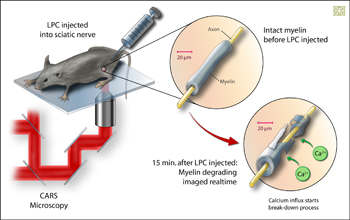News Release 07-072
New Imaging Technique Could Promote Early Detection of Multiple Sclerosis

New imaging techniques could promote early detection of conditions such as multiple sclerosis.
June 27, 2007
This material is available primarily for archival purposes. Telephone numbers or other contact information may be out of date; please see current contact information at media contacts.
Researchers from Purdue University have studied and recorded how myelin degrades real-time in live mice using a new imaging technique. Myelin is the fatty sheath coating the axons, or nerve cells, that insulate and aid in efficient nerve fiber conduction. In diseases such as multiple sclerosis, the myelin sheath has been found to degrade.
This unprecedented feat of looking real-time at the actual progress of demyelination will advance understanding of and perhaps promote early detection of conditions such as multiple sclerosis.
Using a technique called coherent anti-Stokes Raman scattering microscopy, or CARS, scientists observed the injection of a compound called lysophosphatidylcholine (LPC) into the myelin of a mouse. Then, using CARS, they observed an influx of calcium ions into the myelin. This influx is now believed to start the process of myelin degradation.
The research was supported by the National Science Foundation.
-NSF-
Media Contacts
Lily Whiteman, National Science Foundation, (703) 292-8310, email: lwhitema@nsf.gov
Related Websites
Purdue University News Link: http://news.uns.purdue.edu/x/2007a/070627ChengCARS.html
The U.S. National Science Foundation propels the nation forward by advancing fundamental research in all fields of science and engineering. NSF supports research and people by providing facilities, instruments and funding to support their ingenuity and sustain the U.S. as a global leader in research and innovation. With a fiscal year 2023 budget of $9.5 billion, NSF funds reach all 50 states through grants to nearly 2,000 colleges, universities and institutions. Each year, NSF receives more than 40,000 competitive proposals and makes about 11,000 new awards. Those awards include support for cooperative research with industry, Arctic and Antarctic research and operations, and U.S. participation in international scientific efforts.
Connect with us online
NSF website: nsf.gov
NSF News: nsf.gov/news
For News Media: nsf.gov/news/newsroom
Statistics: nsf.gov/statistics/
Awards database: nsf.gov/awardsearch/
Follow us on social
Twitter: twitter.com/NSF
Facebook: facebook.com/US.NSF
Instagram: instagram.com/nsfgov


